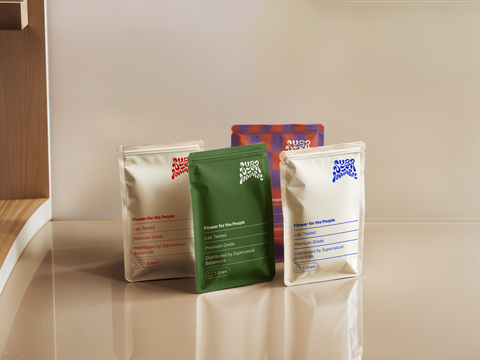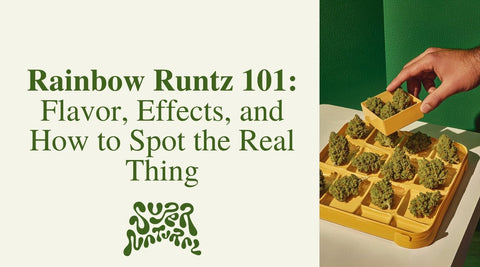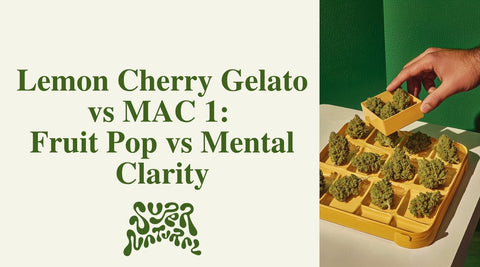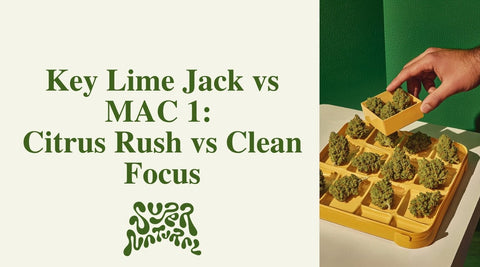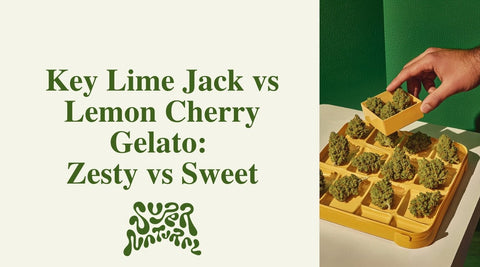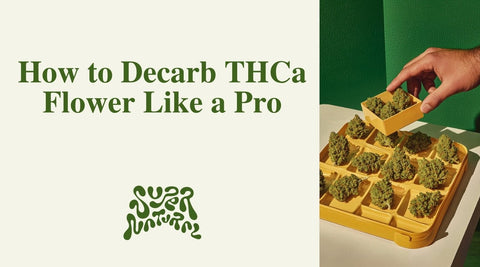
You Gotta Bake It Before You Can Get Baked
THCa flower won’t get you lifted unless you activate it. That activation process is called decarboxylation. It’s how you convert non-psychoactive THCa into delta-9 THC, which is what actually interacts with your endocannabinoid system.
Without decarbing, you’re smoking or eating flower that won’t do much more than taste nice.
Want to keep it simple? Here’s how people decarb flower:
-
🔥 Oven at 220–240°F
-
🫙 Mason jar in a slow cooker
-
💨 Smoking it (yes, that counts)
Each method works, but what you choose depends on your goals. If you’re making edibles or oils, you’ll need something more controlled. If you’re smoking or vaping, you’re decarbing in real time. But no matter how you activate it, the quality of your starting material matters most. A cheap nug full of pesticides and heavy metals won’t magically become safe or potent after a decarb.
That’s why we recommend starting with our Flower Flight. It’s a rotating lineup of exotic, full-panel tested strains you can try without committing to a full ounce. You get variety, verified potency, and peace of mind that what you’re working with is actually worth your time and lungs.
In this guide, we’re going deep. You’ll learn what’s happening during decarb, how to do it properly, the best tools and temps to use, and what kind of high you can expect. Whether you’re baking, infusing, or just getting curious, this one’s for you.
The Science: Why Decarboxylation Is the Key to Getting Lit
Decarbing sounds technical, but the logic is simple. You heat THCa and it becomes THC. That’s it. Without that heat, your flower stays chemically inactive, no matter how loud it looks or smells.
If you’ve ever swallowed raw THCa and wondered why it didn’t land, this is why. Understanding the process isn’t just for nerds or chefs. If you care about the strength, legality, or therapeutic potential of your weed, this matters.
What’s Really Going On With THCa
In its raw form, cannabis produces THCa. That "A" stands for acid, as in carboxylic acid. THCa is THC with an extra carboxyl group attached. This group prevents it from binding to the brain's cannabinoid receptors, which means you won’t feel high, no matter how much you consume.
When you apply heat, that carboxyl group gets removed. It literally burns off as carbon dioxide. What’s left is delta-9 THC, the compound that gives cannabis its psychoactive effects.
Once the THC is activated, it can be absorbed into the bloodstream and cross the blood-brain barrier. That’s when you start to feel it. It’s also when the therapeutic potential kicks in, because THC is far more bioavailable and pharmacologically active than its acidic precursor.
Decarbing Happens Naturally, Just Not Fast Enough
Time and exposure to the elements will eventually decarb THCa. That includes light, air, and ambient temperature. But unless you plan to store your bud in a hot car for several months and hope for the best, that’s not a practical strategy. Natural decarboxylation is slow, incomplete, and unpredictable.
Controlled heat is the only way to get consistent, reliable activation. It allows you to convert the majority of THCa into THC in a short amount of time. This matters whether you’re making edibles, capsules, topicals, or just want to make sure your joint hits properly.
Why This Matters Legally
This is where things get messy. THCa in its raw form is federally legal under the 2018 Farm Bill, as long as delta-9 THC content stays under 0.3 percent by dry weight. But once you decarb it, that same flower becomes high-THC cannabis.
In some states, that change puts you outside the law.
If you live in a prohibition state or one that has not clarified THCa regulations, converting it at home could be considered the manufacture of a controlled substance. Always check your local laws before decarbing your stash, especially if you plan to store, travel with, or share it.
Do You Need to Decarb THCa Before Smoking It?
If your plan is to roll it, pack it, and light it, you don’t need to decarb your THCa flower first. Combustion takes care of that for you. The heat from a lighter or match is more than enough to strip off the acidic group and turn THCa into THC on contact.
This is why smoking works even when you’re starting with raw flower. The decarb happens instantly as soon as the flame ignites herbal matter.
Still, some people choose to pre-decarb their flower before smoking or vaping.
The reasons vary. Some are rolling infused pre-rolls and want to ensure consistency across batches. Others are working with low-temp vaporizers or smoking methods where full conversion might not happen in one hit.
There are also folks who just want to make sure every bit of THCa gets activated without guessing. We can respect that.
Best Methods for Quick Decarbing
-
Oven at 240°F for 30 to 40 minutes
This is the go-to method for even heating. Use a thermometer to avoid burning off terpenes. -
Air fryer
Some use this for small batches, but temperature control is unreliable. Expect mixed results. -
Toaster oven with built-in thermometer
Great for controlled small batches. Just make sure the heating element isn’t too close to the tray.
One note on expectations. If you decarbed your flower and still didn’t feel anything, the problem might not be the process. It’s usually because the product was old, poorly grown, or improperly stored. Quality matters more than method when it comes to getting high.
Decarbing THCa for Edibles: Activating the Power of the Flower
If you’re planning to eat your weed, you have to decarb it first. There’s no workaround. Raw THCa will not get you high when digested. The compound is too unstable to survive your digestive system in a form that your body can absorb.
Without decarbing, you’re just adding unactivated cannabinoids to fat, and you’re not going to feel the results. Proper decarboxylation is what allows THC to bind to lipids and be absorbed into the bloodstream through the digestive tract.
In other words, it’s the entire reason your edibles work.
Why You Have to Do It
You can’t skip this step. Without it, you’re eating raw flower with trace levels of active THC. That means no psychoactive effect, no therapeutic benefit, and no potency. Decarbing unlocks the THC and makes it bioavailable.
That’s what lets it infuse into oil, butter, or alcohol and eventually reach your cannabinoid receptors. If you’re making edibles and you want results, this is where it starts.
Method #1: The Oven
This is the classic approach. It works well for most users and gives consistent results if done carefully.
Steps:
-
Preheat oven to 240°F or 115°C
-
Break up flower with your fingers, not a grinder
-
Spread it in a thin layer on a parchment-lined baking tray
-
Bake for 35 to 45 minutes, stirring gently at the halfway mark
-
Look for golden brown color and a nutty aroma
This method produces a strong smell. If you’re in an apartment or shared space, take ventilation seriously. Some users tent their trays with foil to hold in terpenes.
Method #2: Mason Jar in Slow Cooker
This is a low-odor, terpene-friendly option. It’s slower but easier to control.
Steps:
-
Lightly break up your flower
-
Place it in a mason jar and seal tightly
-
Fill your slow cooker with water to about halfway up the jar
-
Set to low, around 200 to 210°F
-
Let it cook for 90 minutes, shaking the jar every 30 minutes
Because the jar stays sealed, the smell is minimal. It also preserves more flavor and aroma, which can improve your final edible.
Method #3: Oil Bath
This one is for precision users and people making tinctures or infusions. It takes more equipment but allows for tight temperature control.
Steps:
-
Fill a pot with cooking oil and heat to 250 to 275°F
-
Place your flower in a sealed glass container or lab beaker
-
Submerge the container in the oil, making sure no oil touches the flower
-
Decarb until bubbling stops, usually around 45 to 60 minutes
-
Remove, cool, and store
This method is ideal for preserving terpenes and cannabinoids, especially for folks making medical-grade edibles or topicals.
What to Expect from Edibles Made with Decarbed THCa
Once your THCa is properly decarbed and infused, the effects of your edible will depend on several variables. These include how well the decarb process went, what strain you used, how much you consumed, and how your body metabolizes cannabinoids.
Unlike smoking, the high from edibles takes time to arrive and tends to last much longer. This delay is where many people go wrong. They assume nothing is happening, take more, and then get hit with a wave they didn’t see coming.
Common Effects
If your decarb and infusion were done right, expect effects to show up within 30 minutes to two hours. The duration can stretch anywhere from four to eight hours, sometimes longer depending on your tolerance and what you ate that day.
-
Elevated mood with a subtle or strong mental lift depending on dose
-
Giggles and euphoria especially with more uplifting strains
-
Deep body high that settles into muscles and joints
-
Introspective thoughts or heightened sensory awareness
Some users describe it as a cleaner, more full-bodied high than smoking. Others say it hits harder and lasts longer, which can be great or too much depending on the context.
Watch for These Issues
If your flower was overcooked, THC can convert into CBN. CBN is not as psychoactive and tends to produce a sleepy or numbing effect. Some people like it, others find it too sedating.
On the other hand, if you don’t feel anything at all, the issue might be under-decarbed flower or poor-quality source material.
Always start low and wait before taking more. The delayed onset of edibles is the most common cause of overconsumption. Patience makes the difference between a good experience and a regrettable one.
How to Find THCa Flower Worth Decarbing
You can follow every step perfectly, measure every temperature, and still end up with weak or disappointing edibles if the starting flower isn’t clean or potent. That’s the truth most people overlook.
THCa flower is unregulated in many states, which means plenty of vendors are moving mid-tier product with no transparency. Some skip testing entirely. Others rely on a single potency result and ignore everything else. That’s not just a quality issue. It’s a safety risk.
If you’re going to decarb and eat your flower, you need to know it’s free from mold, heavy metals, and pesticides. Inhaling contaminated cannabis is bad enough. Ingesting it pushes the exposure deeper into your system.
What to Look For
-
Full-panel testing that includes mold, mycotoxins, pesticides, and heavy metals
-
Freshness because THCa potency drops over time, especially with light and oxygen exposure
-
Trusted sources that show real reviews, verified test results, and clear strain descriptions
THCa content means nothing if the flower has been poorly stored or grown in subpar conditions. That’s why sourcing from experienced growers and honest retailers is everything.
Why SuperNatural Is the Source You Want
SuperNatural isn’t just another site reselling flower. We’ve built our reputation on doing things the right way, even when it’s harder. Our founders come from cultivation, cannabis marketing, and lab testing backgrounds.
Every batch we carry goes through full-panel screening, not just for potency but for contaminants that most brands ignore. If a batch doesn’t meet our standards, we send it back. Simple as that.
We blind test new strains, smoke them ourselves, and only stock the ones that deliver on both flavor and effect. That’s how we maintain consistency across our drops, and why our customers keep coming back.

Try These High-Potency Strains
Lemon Cherry Gelato hits with a citrus-heavy sweetness and a fast-acting euphoric lift. It’s ideal for edibles when you want flavor and a bright, balanced high.

Mac 1 offers creamy, earthy notes and a more cerebral edge. This one leans into the body while keeping the mind active.

Udder Madness is loud in every way. Dense, potent, and incredibly sticky, it’s the choice for people who want full throttle effects in every form.

Treat Your Flower Right So It Can Treat You Right
Decarbing THCa flower is less about fancy technique and more about respect. Respect for the plant, for your body, and for the process that turns one into fuel for the other. Skip steps, and you waste good weed. Follow through, and you unlock everything it has to offer.
It starts with clean, potent flower grown and selected by people who actually care what ends up in your stash. That’s where we come in. We test like regulators, smoke like connoisseurs, and never settle for less than fire.
To discover high-quality flower that deserves to be activated, head over to our THCa flower collection and look at some of the strains we stock.

